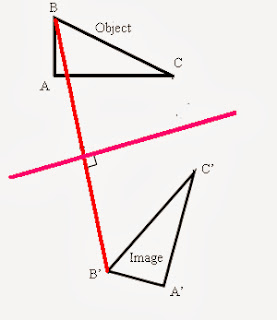Firstly, you will have to identify clearly in your mind which one is object and which one is image. Many students tend to be careless and interchange them which resulted in errors.
Let's say you are given an object ABC and image A'B'C' under a rotation.
If there is no labels, you must decide the pairs according to what we have learnt on how to find the congruent pair.
The next step is, draw a line to join the pair e.g BB'
Then, construct the perpendicular bisector of BB'
Construct the perpendicular bisector of the line CC' as shown.
Label the centre accordingly e.g. as O.
Next measure the angle of rotation. Draw a line from the centre of rotation to one of the pairs e.g. AA', BB' or CC'. In this diagram it is most convenient to draw them from C to O and C' to O. Then, using a protractor, you measure the angle. The angle shown is about 75 degrees and object is rotated anticlockwise.
When required to describe a transformation such as this, include details about the type of transformation, the centre of rotation and the angle according to its anticlockwise/clockwise rotation.
In this case, the transformation is a rotation at centre labelled as O (or mention the coordinate, if given in a cartesian plane), angle of rotation 75 degree anticlockwise.
If you need a video on this try this one.
Good luck.






No comments:
Post a Comment